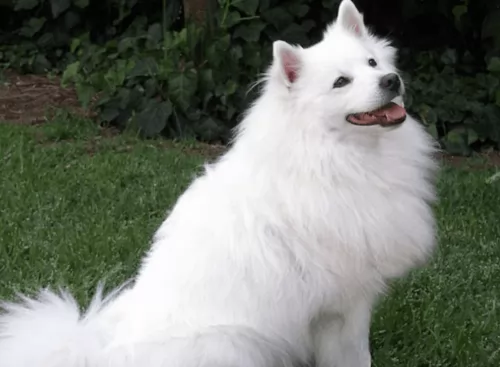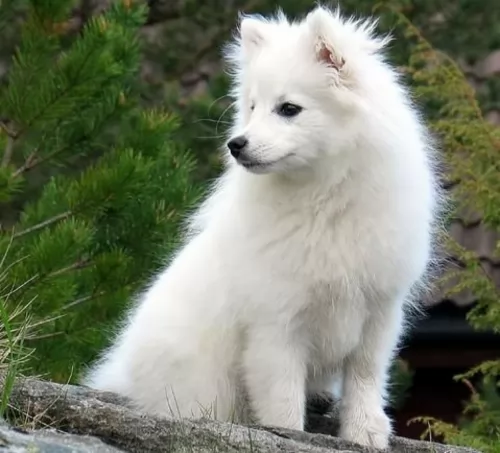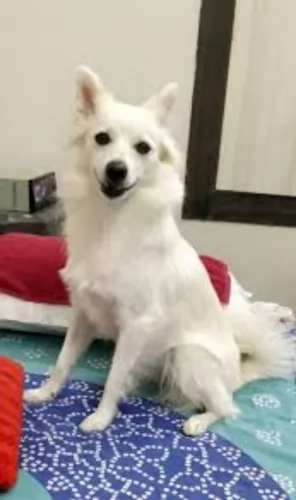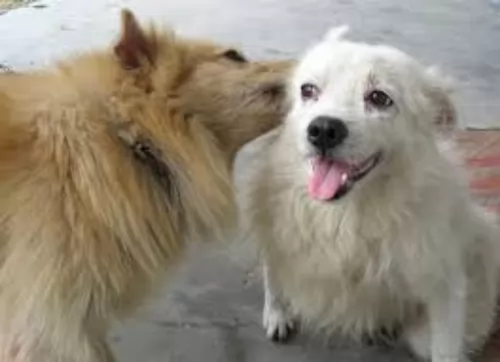 MyDogBreeds
MyDogBreeds Havanese is originated from Cuba but Indian Spitz is originated from India. Both Havanese and Indian Spitz are having almost same height. Both Havanese and Indian Spitz are having almost same weight. Both Havanese and Indian Spitz has almost same life span. Havanese may have more litter size than Indian Spitz. Havanese requires High maintenance. But Indian Spitz requires Moderate maintenance
Havanese is originated from Cuba but Indian Spitz is originated from India. Both Havanese and Indian Spitz are having almost same height. Both Havanese and Indian Spitz are having almost same weight. Both Havanese and Indian Spitz has almost same life span. Havanese may have more litter size than Indian Spitz. Havanese requires High maintenance. But Indian Spitz requires Moderate maintenance
 The only breed of dog that is native to Cuba is the Havanese. These little dogs are great companion animals. Sociable and happy, they are very popular in the United States with urbanites. These happy little pups are a Bichon type of dog which was developed from the “Little White Dog of Havana” or the Blanquito de la Habana which is now extinct.
The only breed of dog that is native to Cuba is the Havanese. These little dogs are great companion animals. Sociable and happy, they are very popular in the United States with urbanites. These happy little pups are a Bichon type of dog which was developed from the “Little White Dog of Havana” or the Blanquito de la Habana which is now extinct.
The Blanquito de la Habana was itself developed from another extinct breed the Bichon Tenerife. Then the Blanquito was bred with the other Bichons and poodles in developing the Havanese. It is believed that some of the first people to settle in Cuba were from Tenerife, an island close to Cuba. In the early part of the sixteenth century, little white dogs were brought to Cuba with these settlers. This dog of Tenerife is believed to be the ancestor of all Bichon breeds.
At that time trade with Cuba was highly restricted by the Spanish and so these dogs developed without any crossing from other breeds from outside the country. They grew to be able to stand hot temperatures and they grew a very unique coat – almost like silk. Their coat is soft and light, while insulating them from the tropical environment.
At this time Cuba was the place to be for Europeans aristocrats on vacation. Unlike the British colonies, Cuba had theatres, operas and palacious. When going back to Europe, many took this little white dog with them to France, Spain and England. The Dog of Havannah was a favorite on European soil as well. Many of these dogs taken to Europe were fawn or parti instead of white. Meanwhile back in Cuba, the bourgeoisie were replacing the aristocracy who themselves would soon be replaced by the Revolution.
During the days of the bourgeoisie, the Havanese became very popular household pets. The breed has been a family pet for the last 150 years. At the same time the breed was very trendy in Europe with Charles Dickens and Queen Victoria owning several. They were by now familiar participants in Europe’s dog shows. Finally, with the Revolution, the bourgeoisie left the country in droves with their little white dogs. A genetic pool was then formed in the US. Gene pool from 11 dogs. All the Havanese in the world are descended from those 11 dogs with the exception of the dogs isolated in Cuba and the US. Today the Havanese is one of the most popular and fastest growing breeds in the world.
 The Indian Spitz is a working dog and has always been used for hunting and tracking small game. It is a popular dog breed in India.
The Indian Spitz is a working dog and has always been used for hunting and tracking small game. It is a popular dog breed in India.
There isn't too much information on the exact origin of the dog but dog experts tell us the dogs have descended from different Spitz breeds and wild wolves, and that they date back thousands of years.
People often mix them up with the Pomeranian, but they're different, being introduced in India by the British. The British began breeding them from a stock of German Spitz's and years of breeding produced the ideal dog type which could cope with the tempestuous weather conditions in India.
They aren't recognized by any major kennel clubs but the Kennel Club of India is working to establish the Indian Spitz as a separate breed.
 The Havanese is a sturdy little dog, a member of the toy group. They weigh no more than 16 pounds (7.3kg) and his body is longer than it is tall. The breed has a unique topline that is not level, but it is straight. His front legs are longer than his hind legs producing the lively gait everyone is used to seeing with a Havanese. With a full muzzle that tapers to the nose, the Havanese does not seem to be short. The skull’s length is the same as the muzzle’s. The head of the Havanese is round in the back and flat in the front.
The Havanese is a sturdy little dog, a member of the toy group. They weigh no more than 16 pounds (7.3kg) and his body is longer than it is tall. The breed has a unique topline that is not level, but it is straight. His front legs are longer than his hind legs producing the lively gait everyone is used to seeing with a Havanese. With a full muzzle that tapers to the nose, the Havanese does not seem to be short. The skull’s length is the same as the muzzle’s. The head of the Havanese is round in the back and flat in the front.
They have a deep chest, almond shaped eyes that are dark brown and their ears are about halfway down the nose. The long ears hang down the side od the face. They have a long plumed tail that is held high and upward. The standard for the breed and now the laws of the United Kingdom state that there can be no docking of the tail.
 The Indian Spitz is an attractive, fluffy looking dog breed thought to have been domesticated thousands of years ago.
The Indian Spitz is an attractive, fluffy looking dog breed thought to have been domesticated thousands of years ago.
The dog comes in two sizes – the smaller- and larger size. The Smaller Indian Spitz stands at between 20 - 25 cm and weighs between 5 – 7kg while the Greater Indian Spitz stands at 35-45cm and weighs between 12 – 20kg.
The dog has a long-haired coat, with the hair on the head being shorter than the rest of the body. The color of the coat can be white, brown or black and white.
The Indian Spitz is an easy-going dog which adapts to all kinds of living conditions in India. They therefore adapt easily to life in the city or in the countryside.
The Indian Spitz is a social, friendly dog who is loyal towards his human family, showing his joy at being with them with high-pitched barking. He gets on well with children in the home and because he isn't aggressive, he gets on well with pets in the home too.
He is intelligent which means that he is able to be trained and socialized, turning him into an obedient pet who takes his job as guardian and protector seriously.
 Havanese are highly intelligent and eager to please, and they are easily trained so long as you use only positive methods. This can be a sensitive breed, so care must be taken to not scold them harshly. Socialization from an early age is very important. Expose them calmly to a wide variety of new places and new people, always ensuring that the experiences are positive and not intimidating. Gentle, patient training will result in a wonderful companion dog. They are affectionate with people and get along with other nonaggressive pets.
Havanese are highly intelligent and eager to please, and they are easily trained so long as you use only positive methods. This can be a sensitive breed, so care must be taken to not scold them harshly. Socialization from an early age is very important. Expose them calmly to a wide variety of new places and new people, always ensuring that the experiences are positive and not intimidating. Gentle, patient training will result in a wonderful companion dog. They are affectionate with people and get along with other nonaggressive pets.
The Havanese is the consummate lap dog. Over time they have become the lovable family companion.
The breed is pretty adaptable being able to live as a companion animal in almost any setting. Just don’t expect your Havanese to go hiking or romp with you on 40 acres in the country.
They are intelligent, love to learn but can be a little stubborn. Train them early as they like their habits and its much harder to train an older Havanese.
 Playful, feisty, intelligent, loving and loyal, the Indian Spitz is full of character and just loves being in a loving family home.
Playful, feisty, intelligent, loving and loyal, the Indian Spitz is full of character and just loves being in a loving family home.
Easy to train, he becomes a wonderfully obedient canine friend who loves nothing more than to spend time with you, especially when it is outdoors going for a walk or playing ball.
He is an entertaining little dog too, and anyone wishing to buy a dog like this won't regret it as he brings in a joyful dimension to any home.
 A very healthy breed, the Havanese doesn’t have a lot of health issues, but they are not immune to the problems of small breed dogs. The issues they do have are:
A very healthy breed, the Havanese doesn’t have a lot of health issues, but they are not immune to the problems of small breed dogs. The issues they do have are:
 These feisty little dogs can reach 14 years of age if looked after well.
These feisty little dogs can reach 14 years of age if looked after well.
Your Indian Spitz will need to see a vet when he is 6 weeks of age for his first vaccinations and also whenever he is sick.
He is a dog breed that doesn't get sick very easily, but still it is wise to know about some of the more common dog diseases that could plague your little pet, and these are among others, hip dysplasia, epilepsy, cancer and vision- and dental problems.
It is important to be keeping an eye on your dog's oral health. Infected teeth can have a bad impact on his health and can actually contribute to heart- and kidney disease for instance.
One of the major causes of dental disease in dogs is none other than diet. Always try to feed your pet the best quality food there is. Certainly if you feel your pet isn't getting the best food, try a probiotic supplement as this can create a healthy bacterial environment in your dog’s mouth.
Check your pet's mouth regularly so you can attend to any dental problem before it gets out of hand.
 Feed 3 to 4 times per day a high quality dry puppy food for toy or small dogs. Feed ¼ to ½ cup each time.
Feed 3 to 4 times per day a high quality dry puppy food for toy or small dogs. Feed ¼ to ½ cup each time.
Remember these are small dogs and don’t overfeed. Feed a high quality dry food for small or toy dogs. Feed twice a day at about ½ cup each time.
The breed is generally very healthy.
This breed is not an overly active dog, but he does need some exercise. A nice walk once a day or a backyard to play in. They play inside as well as out. Don’t over exercise the Havanese. They do well in obedience and confirmation more so than agility or fly ball
 These dogs have been used to a diet of milk and rice, but if possible it can be beneficial to the dog to include some cooked chicken and vegetables too. Raw meat is also important, but it is expensive, so just adding it in from time to time can still be beneficial. Water which is cool and clean should be available to the dog day and night, non-stop.
These dogs have been used to a diet of milk and rice, but if possible it can be beneficial to the dog to include some cooked chicken and vegetables too. Raw meat is also important, but it is expensive, so just adding it in from time to time can still be beneficial. Water which is cool and clean should be available to the dog day and night, non-stop.
Your Spitz dog will simply require a brush twice a week to keep it clean and vibrant and free from loose hairs. While brushing him, make a point of checking him for fleas and ticks as well.
This is a busy little dog that wants to involved in everything you're busy with. He will love to join you in your long walks each day or if you take him to the park, he will love the chance to run off his leash.